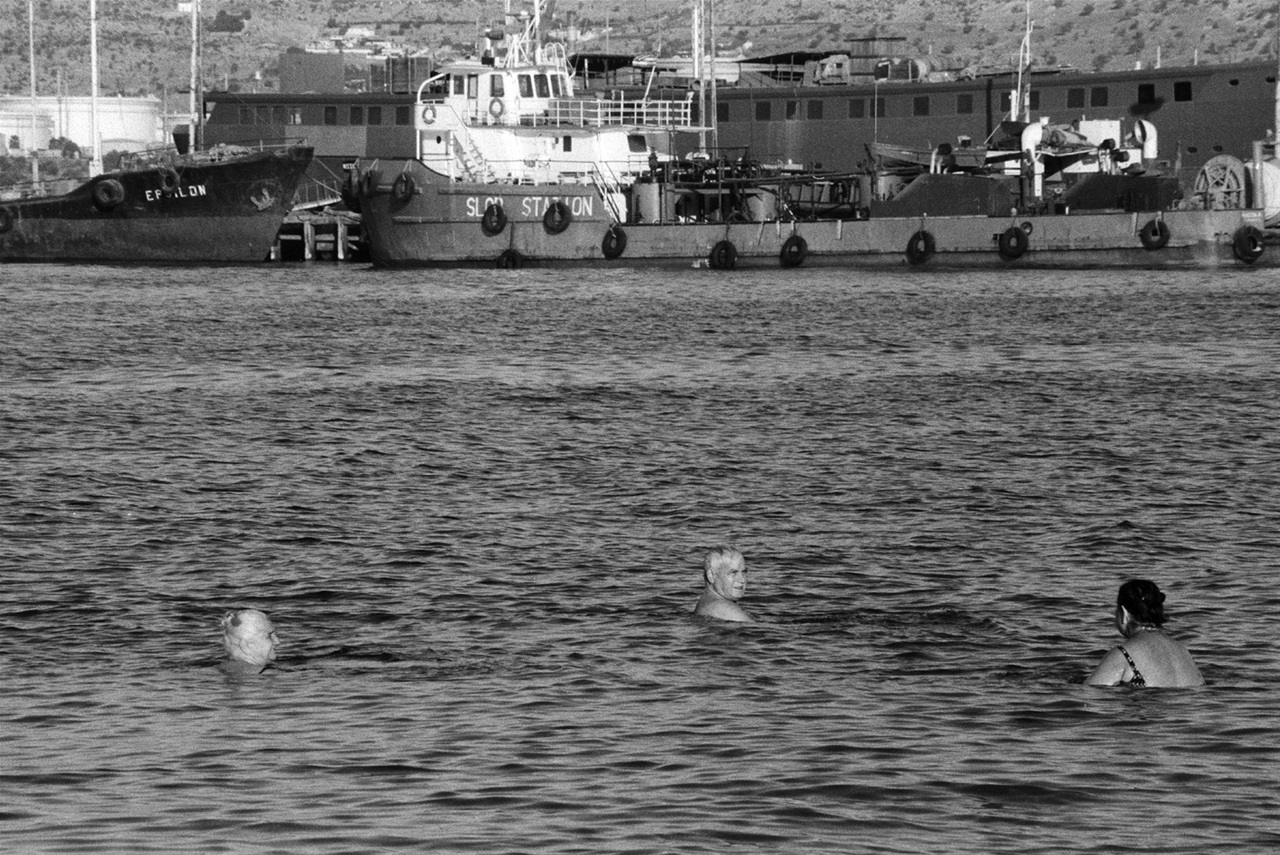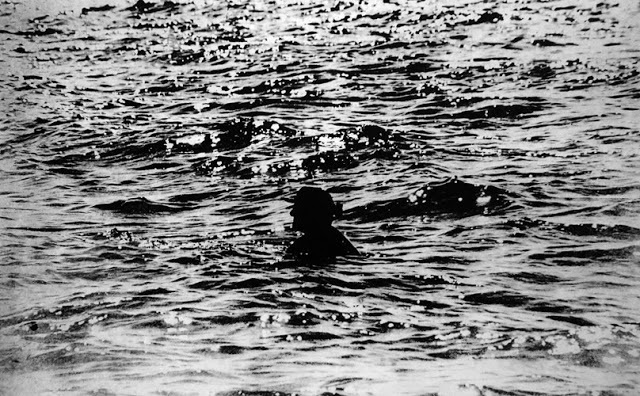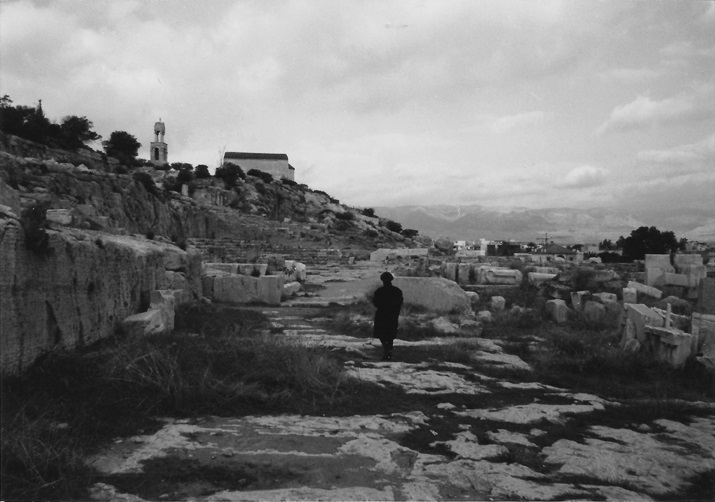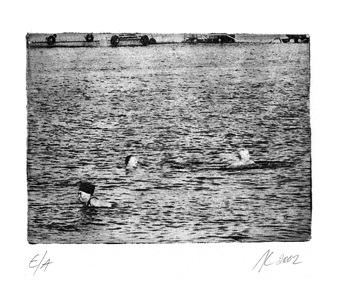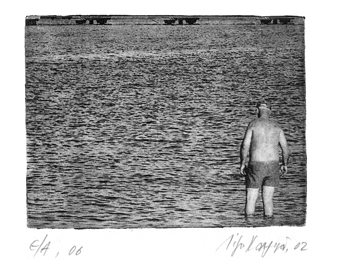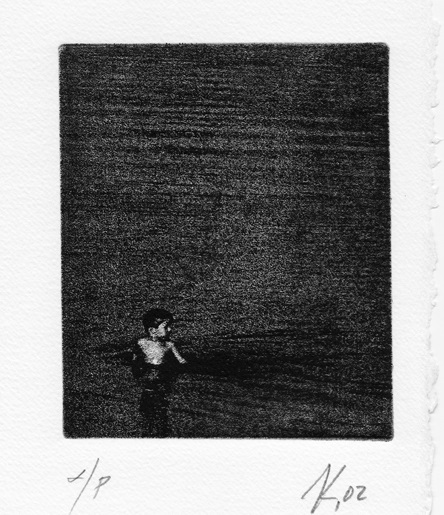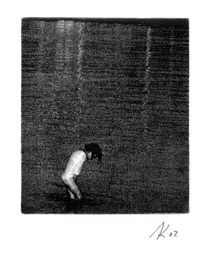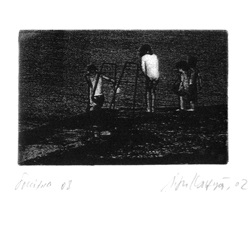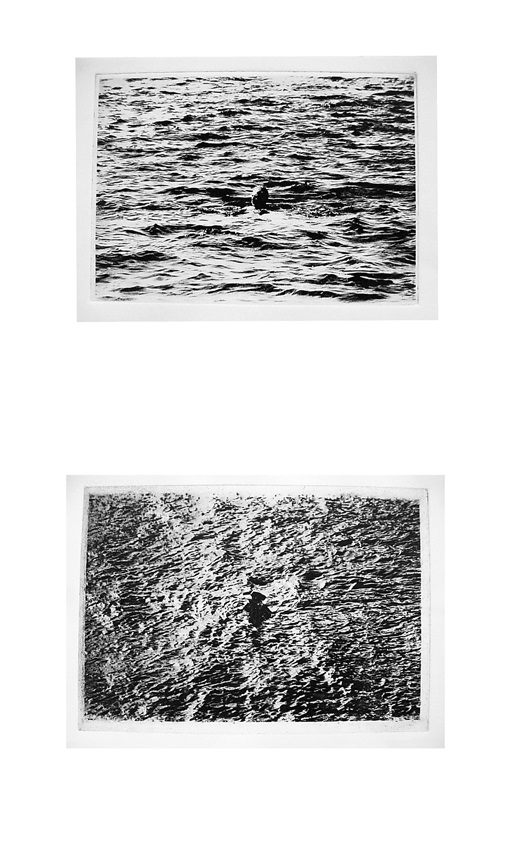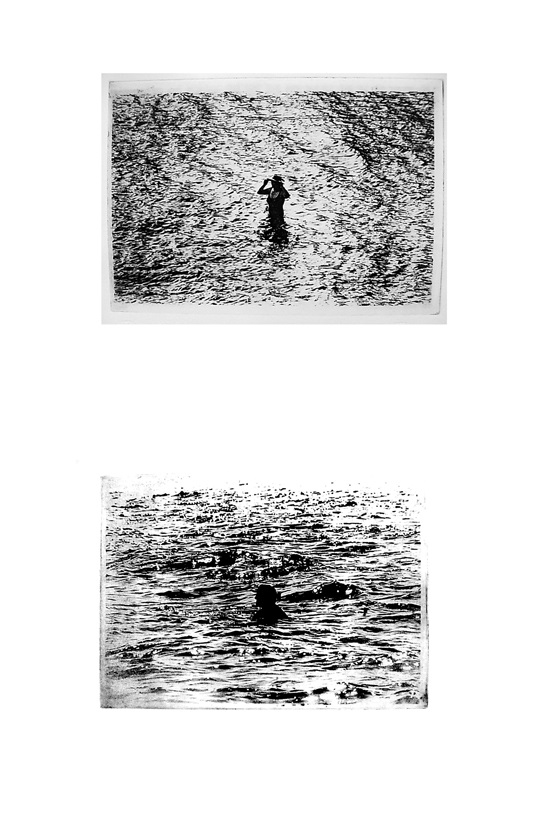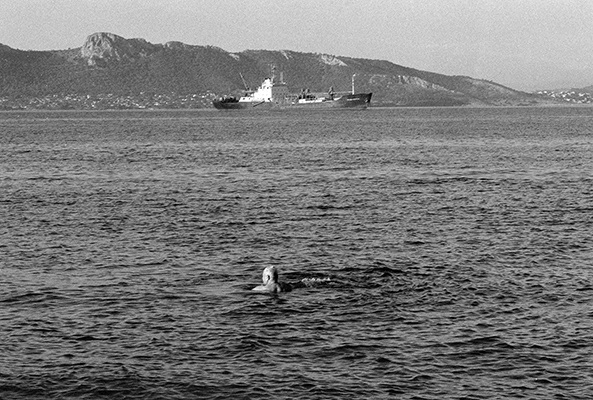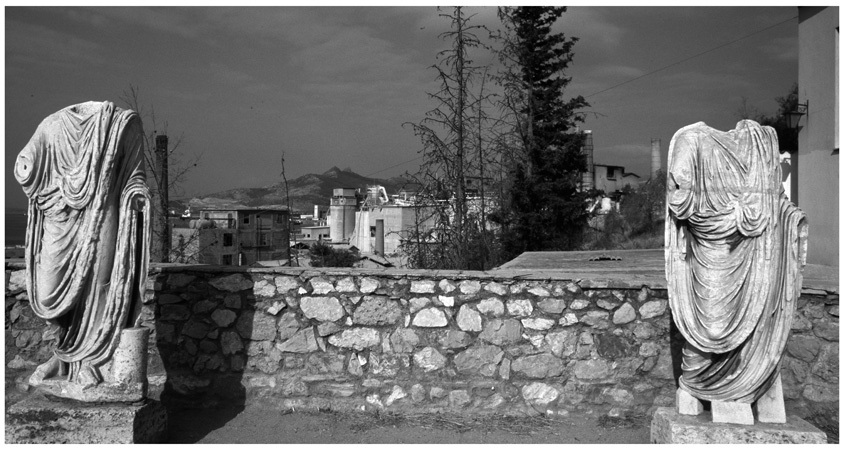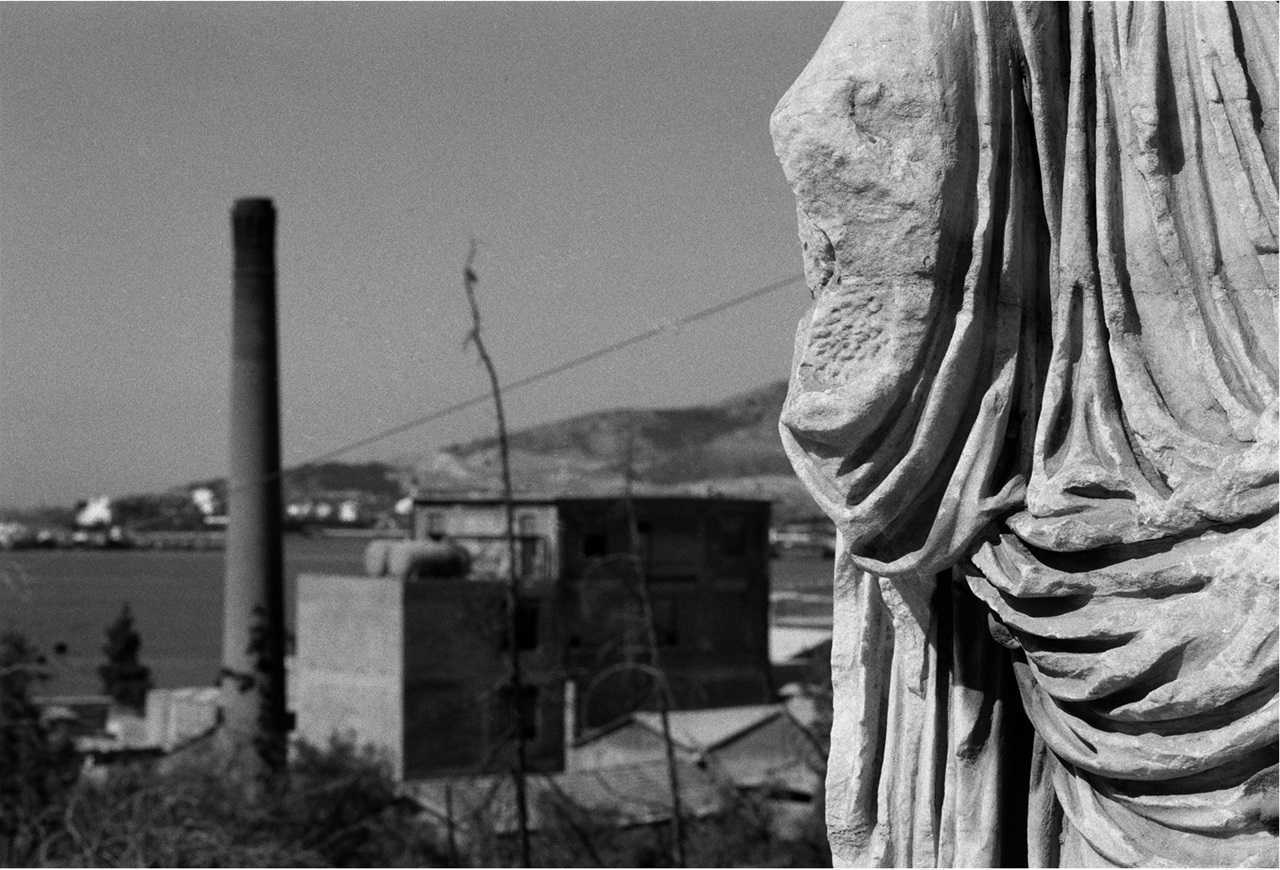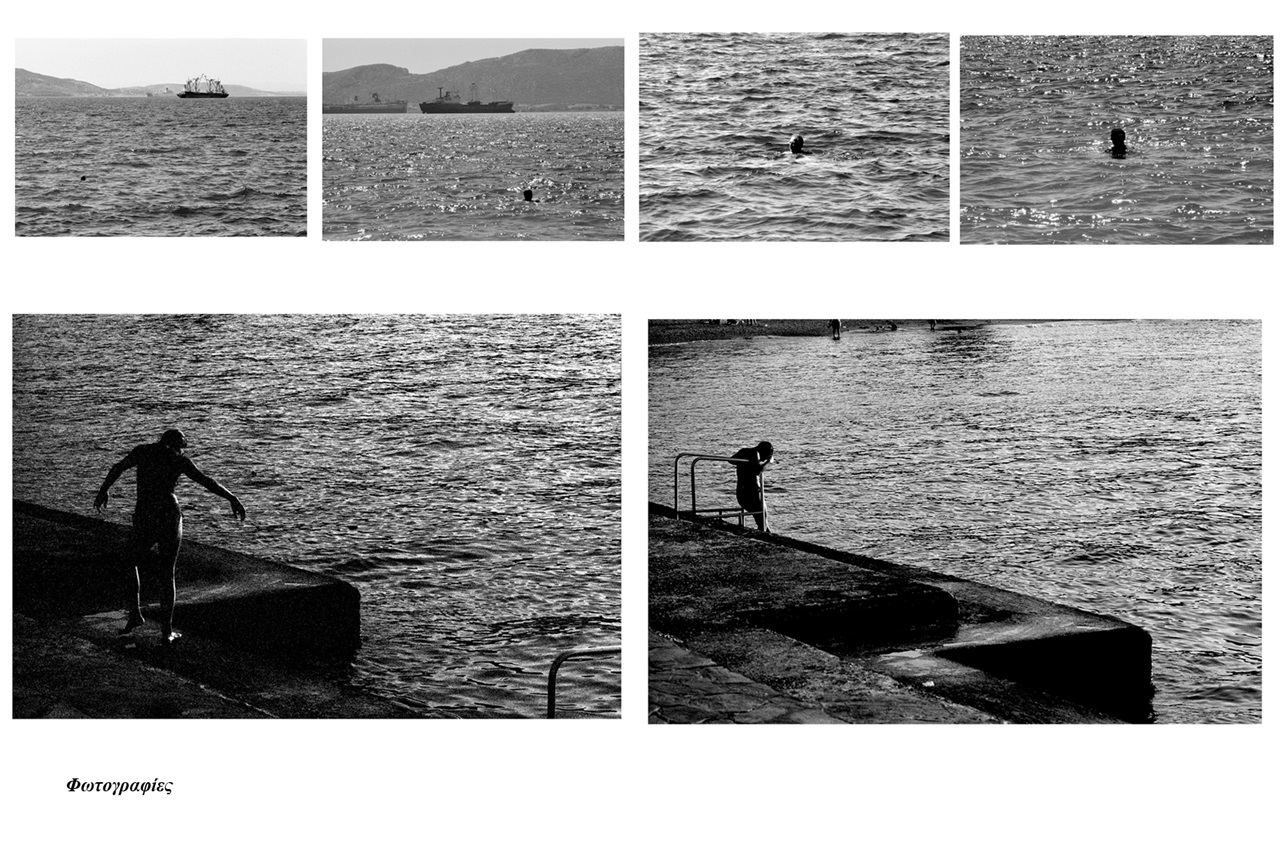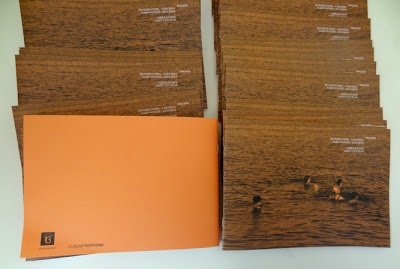Rarely is a title able to convey the purport and essence of an art work as intently as in this work by Lizzie Calligas. Dark Waters simultaneously concerns the process of art production, its raison d'être, the very material on which it is captured and through which it emerges. The title, moreover, conveys an almost symmetrical correspondence with its point of reference, Elefsina, as a medium in which images, faces, experiences, memories, concerns, trajectories, and revisits are submerged, and from which they emerge, in alternation, spanning an indeterminate scope of time that encompasses our childhood, modern history and ancient myth, harking back to the distant origins of human existence. One can obviously begin to contemplate on the presence of Elefsina in a Modern-Greek's life and thought through one of the above points of view. The Elefsina of factories and smokestacks may be the most immediate one, as we drive through it by car after Skaramangas on our way out of Athens, when the landscape and social space emerges in front of our eyes like a fold that envelopes the world and man as they are submerged and at the same time emerge in front of our eyes. A world accompanied by bathers' figures fading away in the reflections of a powerful image of the Greece of our childhood emerges nearby, from the rocks seen by the side of the road falling into the sea, as if into pitch-black tar. These human figures, who always went into the water from the rocks, diving by ships and near factories, totally negate the concept of a tourist beach of the 1960s, conjuring the image of another Greece. A socially and politically dark view of Greece, as dark as these waters, in which those people swam with such unassuming dignity. Considering our personal memories related to man in space, we are amazed by the extent of the inescapable individualization of the human being in the world. Contrary to Hellenic Tourism Organisation-run beaches, where beach takes precedence over water and people gather in crowds, sharing their leisure, playing games, joking, with their swimming suits, transistor radios, sandwiches and refreshments – the illusion of an American Dream of generalized prosperity – these images of bathers in Elefsina's waters evoke the complete absence of a beach. Here, the beach as the vital space for leisure is eliminated. On the contrary, these images document a social identity in which men are created equal with each other through labour, rather than leisure, through the body, rather than clothing; their weight enters the water as if it surrendered all sociability, as if it were able to find that unique moment of individualization between heaven and earth, or rather, between darkness and glowing reflection, the moment when man is freed from his image. For almost 20 years, these photographs by Lizzie Calligas have had as their starting point this image, the same that greets the visitor upon arriving at the first rocky shores of Elefsina, before eventually approaching a time closer and closer to that anonymous yet individual human figure that stands in front of us, suspended in cosmic space. A figure held suspended, with all of the load of life and reality, by the dark waters that open up beneath. Those dark waters that absorb him, from which rushes out all the lightness of the upthrust and diffusion introduced at the moment when the introspective reality is diffused through what the Greek poet Sikelianos called "the realized body". A body that is liberated from its clothing, its conventions, its oppressions, its social limitations, from the pressure of work and necessity, from the load of responsibility and poverty. A body that is indeed able, albeit for a brief moment, to stand within its centre of gravity, effortlessly, as the water pushes it towards the surface to share the diffusion of daylight. It is remarkable how Calligas' work during these 20 years has incessantly evolved tracing that fold, now opening and now closing, now folding within itself and now unfolding (the fold that Gilles Deleuse and Michel Foucault have placed in what is perhaps the most specific limit of meaning and thought) and which, in Elefsina, in the dark waters, Calligas encounters as the limit between earth and sea, between the ancient and the modern world, between humans and their environment, between light and darkness, photography and drawing, gesture and line, the present moment and time, between reminiscence and presence. It is this fold that she encounters as things appear or disappear in front of our eyes, as they fold back into themselves or unfold in space. In this intermingling of worlds, circumstances, times, meanings and practices, it could almost certainly be said that – unless concentration is lost, unless anecdotal and picturesque stories carry us away – we, too, remain suspended amidst these prismatic reflections of meaning and code in Lizzie Calligas' work. Through her ongoing investigation of place and a variety of ways of approaching it at a time when digital technology has all but eliminated analogue photography, the artist arrives at an accomplished image, in which the presence of analogue reality, both positive and negative, is inherent in the image itself. It may certainly be said with respect to "bathers" that the waters are dark because they provide no hint regarding depth, but only regarding density. The photographic image is composed so that the prismatic diffraction of light and shadow is so systematically shared – by its very nature - on the photographic surface that it could very well be either negative or positive; it would make no difference, either way. The question of technology is therefore assimilated by a much broader issue, that is, the methods of capturing or depicting reality. Whether a drawing, a gouache, a print, an analogue or digital photograph, the paper surface itself becomes the perceived boundary – the fold – that either folds the transparency into its dense state (that is, into itself) or unfolds it in the diffusion of its physicality (that is, the infinity of transparency). In either case, the world behind the transparency or in front of the surface density is an elusive world, another world that remains dark and unfathomable. It might be said that, without illustrating anything, without depicting a specific subject even, Calligas' work interrogates, simply by showcasing that moment when art work and viewer reach the fold and find themselves, in turn, suspended between two worlds that never allow them to become either object or comment. Especially characteristic of such a reciprocal condition are the two photographic views in which we see side by side a series of folds unfolding on an ancient Greek marble statue and the series of factory chimney stacks that form dense patterns against the skyline. Both Elefsina and human beings find themselves suspended like a bather between the dark waters and the light diffused by the folds of the marble or condensed into a solid pattern through the chimney stacks that almost negate the skyline. In her early photographs, dating from the 1990s, the white bodies in the foreground and the white ships in the background leave the sea water as the medium par excellence – neither dark nor light – that merely gathers up a specific density. From then on, up to the latest photographs twenty years later, water literally becomes dark waters, equally dense and diffuse, both bright and unfathomable. In all its scope and continuity, Lizzie Calligas' work has undergone successive oscillations in the relationship between opacity and surface, transparency and diffusion, alternately reaching the limits of metaphysics as a feeling of individualization and the limits of history as a personal perception of the fact. Many a page could undoubtedly be written to do justice to a work that, before reaching its present phase, went through a twenty-year-long process of elaboration that speaks volumes for the scale and substance of Calligas' oeuvre, as well as for the breadth and scope, and the history, of Elefsina. Nevertheless, there comes a time when wisdom in a work of art lies in not commenting, not developing, not analysing. It captures, participates and continues. By observing how these photographs are identified, one realizes how they constantly put off any identification, only to eventually remain consciously suspended in the face of classification, of imposed order. At this point, the fold neither unfolds nor folds; it arrives at the darkest root of our anguish – death – and at the brightest branching out of knowledge – diffusion. Multiple approaches to Calligas' work bring out diverse views and variegated articulations of the same thing, underlining the need to think on different levels and to experience in various ways what we earlier called "the realized body", in Sikelianos' words. Just like the poet, Calligas each time wonders or poses a question for those who wish to hear it articulated in today's speech, to this effect: You are the point. You are the little breath That suddenly releases the huge tempest… Can't you hear? She listens closely to the resonances of image and memory as they fade out in the dark waters, as they are outlined by the light of a contemporary artistic gesture of today. As for us, the work invites us to listen closely, too, and to realize the density of the dark waters, to participate in the diffusion of this writing, full of light, to touch upon the continuity of meaning that, as a fold, either folds or unfolds along with us. An artistic process of exemplary completeness, Lizzie Calligas' Dark Waters joins a series of propositions in which the artist completes, with extraordinary sensitivity and commitment, parallel routes to an inner-self trajectory that evolves alongside a contemporary visual-art language. She moreover epitomizes places and moments in which the experience of history is distilled as an opportunity for many different people, for many different generations perhaps, to share the same experience. What is important in Calligas' work is that this experience has nothing to do with ideological constructions and generalisations. It is most specific, and almost immediately recognizable as a secret link of human sensitivity. The bus route and Iera Odos, the Sacred Way, the dislocation of the Acropolis sculptures, and the transformation of a holy site to a barren landscape, the reflections of light in a dark room, and the memory that arrests the experiencing of time, the resurfacing of the bathers from the dark waters of Elefsina, rising up to the surface almost like Persephone ascending from Hades: these are neither thematic approaches nor cultural symbolism. On the contrary, they capture personal experiences that occur all around us, in public space, in our everyday experiencing of history and community. Nevertheless, they must be discovered like secret glimpses into a microcosm that opens up unexpectedly from the other side of the macrocosm of generalities for those who yearn to see it. This could go unnoticed by many people. Yet, once you see it, once you come near it, it furnishes another measure of reality, discreetly yet efficiently subverting hierarchies and conventions. After two decades of work in the social domain, on art and, above all, on herself and her work, Lizzie Calligas projects, in Dark Waters, an especially topical and pressing view of the artistic act, of cultural awareness, of social involvement today.
Denys Zacharopoulos
Translated by Dimitris Saltabassis
